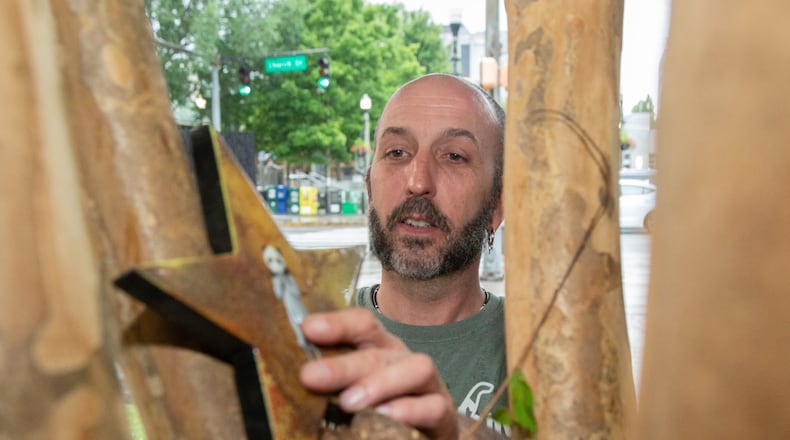One summer day in 2010, an artist stood on a street corner in Inman Park and bolted to a stop sign a 6-by-10-inch piece of wood emblazoned with a detailed screenprint of an image that looked like a cross between a super hero and a Viking. He snapped a picture then posted it on Facebook and Twitter with a message that it was free for whoever could get to it first.
With that one gesture, Kenn Twofour started the Atlanta chapter of Free Art Friday – a global concept he learned about from a British artist. The citywide scavenger hunt began as an occasional activity for in-the-know locals, but has exploded in a massive way, with thousands of hiders and seekers participating over the past eight years.
“Putting free art on the street for people to find isn’t a new or original concept, but I like to think that my contribution to the movement was organizing and boosting its visibility through social media and encouraging people who might not have made art before to start making art,” said Kenn Twofour, 48, who now lives in Portland, Ore.
Twofour was partially influenced by Evereman, aka Jay Wiggins, known for his trademark image he's plastered around Atlanta and the world since 2003: a simple, boxy, robotic face stenciled onto wood. He estimates he's distributed 30,000 pieces over the last 15 years. Although he doesn't use the #FAFATL hashtag, many consider Evereman the founder of Atlanta's free art movement. He and FAFATL are "doing the same thing," he said.
“It’s just been an organic growth from the beginning,” said Evereman, speaking from Seattle, where he’d gone to distribute 60 stencils. “I never had any ideas about this thing; I was just doing it. But for me, I’ve never thought of it as free. I’ve always thought of it as gift art in terms of, it’s not free. People’s time is worth something. Materials cost something.”
While Evereman might have been the forefather of the movement, FAFATL brought the idea of free art to a wider, social media-savvy audience.
Free art phenomenon
In the beginning, Twofour painstakingly created Google Maps that showed where pieces from a handful of artists had been hidden. He posted the links on Facebook every Friday, and the number of artworks began to grow as more artists caught on.
Then the FAFATL hashtag, created to eliminate the need for the maps, gained traction after longtime Criminal Records employee Lillian Hughes began retweeting the FAFATL posts on Twitter. The hunt now takes place almost exclusively on Instagram, with drops happening daily, making the name a misnomer.
The slew of participating artists is constantly changing, with easily hundreds, if not thousands, having posted free art since the beginning. While similar treasure hunts in other cities have fizzled — New York City’s #FAFNYC and #FAFNY tags have garnered less than 5,000 combined posts since 2014 — more than 72,000 photos using Atlanta’s hashtag have been posted since late 2011.
On a recent Sunday, Lena Dangerfield, a 23-year-old Georgia State University student and Decatur resident, used subtle clues from an artist’s photo to deduce the drop was in East Atlanta Village. She plucked the artwork — her eighth acquisition — from behind a construction site fence. A tribute to local artist Catlanta, the piece was made from beads melted into a feline shape.
It was a fitting find. It was Catlanta’s posts that led to Dangerfield’s discovery of FAFATL four months ago. She described the act of hunting art as a “well of joy and inspiration.”
Growing pains
The exponential increase in participation in FAFATL has not changed Twofour’s initial vision of a leaderless system.
The self-taught artist from rural Georgia was motivated to curate what he calls an “art show on the streets” by the “stuffy and pretentious” vibe he got at gallery showings of his wooden screenprints combining elements of heavy metal album art, ancient religious symbols and ‘80s skateboard graphics – even at the indie level.
But regulating a social media-based movement has its challenges. The excitement of the early days — what Twofour refers to as the “Golden Age” — ended when he learned that people were hoarding the art; that adults were running past children to grab the art first; and that artists were partnering with corporations.
“It really frustrated me that people were taking this fun little project and turning it into something that had caused negative feelings for folks,” the self-proclaimed grump said. He eventually stopped telling anyone when he dropped free art.
About five years ago, he and his partner moved to Portland, Ore.
“Once enough time had passed, I got over my bitterness, and now I’m putting out free art here in Portland using #FAFPDX,” he said.
“Looking back, I think it’s a great project and I am really proud that I helped it grow in whatever way I did,” he said. “I met a lot of great people. I had little kids tell me how much they loved making art. And I had adults tell me that Free Art Friday had really changed their lives.”
Changing landscape
As the project has evolved, so has Atlanta, where neighborhoods and skylines are constantly changing. Catlanta, aka Rory Hawkins, said such major changes just mean he needs to tell more of a story with his art. In 2017, he hid a piece that depicted a cartoonish cat stretched over the gap left after the I-85 bridge collapsed as the result of a fire set by a homeless man. Catlanta then sold shirts emblazoned with the image and donated proceeds to the homeless.
“I want to make sure that I’m still going and leaving art in neighborhoods all over the city and not just focusing on ones where new development is happening,” he said.
Today, scrolling back through #FAFATL is like rewinding nearly a decade’s worth of such changes.
In 2015, artists dropped a slew of Braves-related art at Turner Field before the team left for Cobb County. Keep scrolling, and you’ll see art placed near the now-demolished “Murder Kroger,” the once-thriving Stone Soup Kitchen or Belly General Store, the vacant Sears building that became Ponce City Market, the old Masquerade on North Avenue.
Photographer Zanna McNeil learned about FAFATL after she posted a photo of a piece of art she saw attached to a post in the Old Fourth Ward on social media. Someone commented that it was free art, but it was gone by the time McNeil returned.
The 32-year-old has found a couple pieces since then, but she is haunted by the one that got away. McNeil plans to start creating pieces herself to hide, so she can be a maker as well as a taker.
“It’s sort of like a random act of kindness if you think about it, only disguised as an urban scavenger hunt, and what’s not to love about that?”
That’s the idea behind what Evereman, Kenn Twofour and every other artist who leaves art out for others are doing.
“A huge part of it is to put something out there that will give someone a moment of pause, to shake you out of your everyday,” Evereman said. “It’s fun, it puts a smile on peoples’ faces, and that is awesome.”
About the Author
Keep Reading
The Latest
Featured





